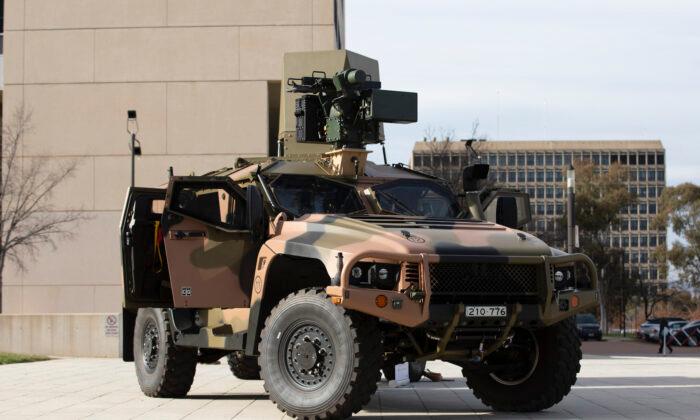Australia has invested $94 million for New South Wales-based space and defence company Electro Optic Systems (EOS) to supply 251 Remote Weapon Stations to increase the lethality of the Australian Defence Force’s (ADF) protected mobility vehicles.
The move comes as Australia invests in the capability to deliver its new defence strategy, which includes sending the message that it is willing to respond with military force to protect its interests from foreign threats.
However, a Department of Defence spokesperson told The Epoch Times the remote weapons stations upgrade is not directed at any specific threat.
“The Australian government routinely upgrades its military capability to ensure the Australian Defence Force is well equipped and supported to undertake its mission ‘To defend Australia and its national interests in order to advance Australia’s security and prosperity,” a Defence spokesperson said.

Linda Reynolds, the federal defence minister, said the investment delivers on the Morrison government’s commitment to accelerate capability initiatives that stimulate the economy and support Australians.
“This capability will improve targeting and better protect our ADF personnel while on operations.”

Melissa Price, the minister for defence industry, said the investment provides stability and continuity for EOS' local workforce and suppliers.
“The project draws on Australian-owned and developed intellectual property, with more than 80 percent of the parts sourced through the EOS' Australian supply chain of more than 140 Australian companies,” Price said.
“This will help to deliver ongoing certainty for the EOS workforce in engineering and support, and certainty for EOS' national supply chain.”

Senator Jim Molan, who visited the EOS facility earlier this month, commended the expertise of the company and its team of more than 300 employees.
“The Morrison Government is committed to maximising opportunities for Australian industry to participate in Defence contracts, where there’s value for money and the highest quality capability can be acquired for our troops,” Senator Molan said.
This work with EOS forms part of the Standardisation of Protected Mobility Vehicles Fleet program within the 2020 Force Structure Plan.
Australia’s New $270 Billion Defence Posture
In July Prime Minister Scott Morrison indicated the COVID-19 pandemic had accelerated changes in the geopolitical landscape and announced the government would invest $270 billion over the next ten years to protect Australia.
Morrison also made it clear that Australia would need a credible, focused defence force so that when “threats do emerge, we can take them further away from Australia.”
“We can’t afford not to have that,” he said.
To that end, the ADF is investing for the first time in an arsenal of long-range missile capabilities.
“Australia’s security environment is changing quickly, with militarisation, disruptive technological change, and new grey zone threats making our region less safe,” the defence minister said at the time.
Grey zone warfare tactics, which the ADF says have become increasingly diverse and aggressive, straddle the line between normal diplomacy and outright aggression—coming in under the threshold for a conventional military response.
The report noted the Chinese regime primarily uses state-issued threats, trade sanctions, and tourism bans; and said Australia had born the brunt of many of the regime’s coercive tactics, copping 27 threats in the last ten years.





